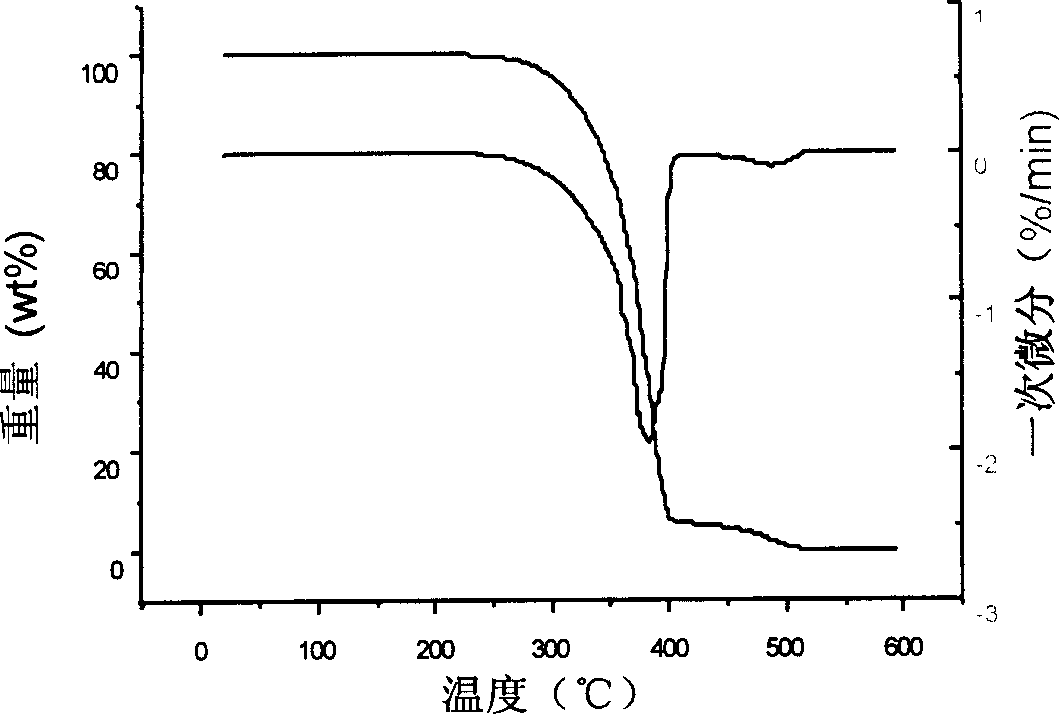Powder method for preparing continaous SIC fiber reinforced Ti alloy base composite material
A composite material and fiber reinforcement technology is applied in the field of preparing continuous SiC fiber reinforced Ti alloy matrix composite materials, which can solve the problem of high preparation cost and achieve the effects of avoiding fiber damage, wide application range and simple operation method.
- Summary
- Abstract
- Description
- Claims
- Application Information
AI Technical Summary
Problems solved by technology
Method used
Image
Examples
Embodiment 1
[0023] Using J801-7A / ZF winding unit and ZRY45B vacuum hot pressing furnace, the experimental process is as follows:
[0024] 1) using polystyrene as a binder and xylene as a solvent, mixing polystyrene and xylene in a weight ratio of 1:1 and fully dissolving to obtain a dissolved binder;
[0025] 2) Take Ti powder, add it into the dissolved binder according to the weight ratio of Ti: polystyrene = 6:1 and mix thoroughly, make 1mm thick flakes and dry them, and then use a hand-operated small rolling mill to divide into 7 passes First time, the thin sheet is rolled into a prefabricated strip with a thickness of 200 μm, and the prefabricated strip is cut according to the mold size for subsequent use;
[0026] 3) Wind the continuous SiC fiber onto a circular stainless steel cylinder with a winding unit, the fiber spacing is 200 μm, and then use polystyrene and xylene to coat the surface of the wire at a weight ratio of 1:1. Fixed, made into fiber cloth; then cut, ready for heat-...
Embodiment 2
[0029] The difference from Example 1 is:
[0030] Using Ti-6Al-4V powder as raw material, add this powder and polystyrene to the dissolved binder in a weight ratio of 7:1 and mix thoroughly to make a prefabricated tape with a thickness of 180 μm. Wind the continuous SiC fiber onto a circular stainless steel cylinder with a fiber spacing of 200 μm, and then use polystyrene and xylene in a 1:1.5 weight ratio to coat the surface of the wire and fix it to make a fiber cloth ;Then cut, ready for hot pressing compound;
[0031] The removal process of the binder is: degassing at 400°C for 2 hours, then raising the temperature to 530°C for 30 minutes; to 870°C, heat preservation for 15 minutes, pressurize to 10MPa first, and hold pressure for 20 minutes; then pressurize to 20MPa, hold pressure for 20 minutes; finally pressurize to 40MPa, hold pressure for 50 minutes) to obtain a plate-shaped composite material sample, The result was the same as in Example 1.
Embodiment 3
[0033] The difference from Example 1 is:
[0034] Using Ti-24Al-17Nb as raw material, this powder and polystyrene are added to the dissolved binder in a weight ratio of 5:1 and mixed thoroughly to make a prefabricated tape with a thickness of 150 μm. The continuous SiC fiber is wound onto a circular stainless steel cylinder with a fiber spacing of 180 μm, and then the surface of the wire is coated and fixed with a binder of polystyrene and xylene in a weight ratio of 0.8:1 to make a fiber cloth; Then cut it for heat-compression lamination;
[0035] The removal process of the binder is: degassing at 360°C for 2.5 hours, then raising the temperature to 480°C for 60 minutes; to 920°C, heat preservation for 15 minutes, pressurize to 5MPa first, and hold pressure for 20 minutes; then pressurize to 15MPa, hold pressure for 20 minutes; finally pressurize to 50MPa, hold pressure for 60 minutes) to obtain a plate-shaped composite material sample, The result was the same as in Example...
PUM
 Login to View More
Login to View More Abstract
Description
Claims
Application Information
 Login to View More
Login to View More - R&D
- Intellectual Property
- Life Sciences
- Materials
- Tech Scout
- Unparalleled Data Quality
- Higher Quality Content
- 60% Fewer Hallucinations
Browse by: Latest US Patents, China's latest patents, Technical Efficacy Thesaurus, Application Domain, Technology Topic, Popular Technical Reports.
© 2025 PatSnap. All rights reserved.Legal|Privacy policy|Modern Slavery Act Transparency Statement|Sitemap|About US| Contact US: help@patsnap.com


